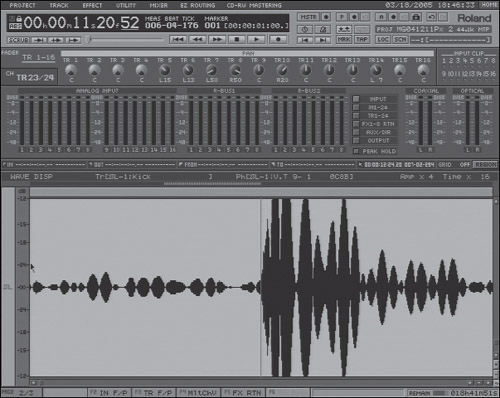Setting Edit Points
| < Day Day Up > |
| Accurately setting your IN, OUT, FROM, and TO points is essential to efficient editing. You can set these points by ear, by eye, or by beat. The Preview ControlsThe Preview controls all deal with a small area of data close to the timeline. Use these controls to set your edit points by ear. The TO control plays from one second before the timeline up to the timeline. The FROM control plays from the timeline to one second after the timeline. The THRU control plays from one second before to one second after the timeline. The TO, THRU, and FROM controls play all enabled tracks in the current mix. The Scrub control continuously loops a small section of audio leading up to the timeline. The Scrub function only plays the currently selected track, not the entire mix. You can adjust the length of time for the Preview functions in the Utility .WAV ViewIn .WAV view, you can see a visual representation of one track's audio data. You can zoom out enough to identify view several measures of audio or zoom in tight for very precise edits. The vertical zoom controls allow you to magnify the visual representation of the audio to find quieter passages. Use the .WAV view to set your IN, OUT, FROM, and TO edit points to reference the actual audio events themselves , as shown in Figure 17.13. Figure 17.13. .WAV view of a kick drum positioned to the timeline Use the cursor buttons to set the focus to the SubFrames value, and use the Time/Value dial to precisely position an event in the .WAV display to the timeline.
Working with Measures and the GridIf you have recorded your project using the VS-2480's internal metronome, or if you used MIDI to sync a drum machine to the VS-2480's internal tempo, you can use the VS-2480's measures and beats counters to set your edit points. This makes it very easy to copy a well- played section to another part of the song and have it remain in perfect time. The grid may be displayed in various densities , from whole measures to 32 nd notes. If the grid is displayed, any edited data " snaps " to the closest grid when moved. The grid is especially useful for editing loops and phrase sequences, but may get in the way when dealing with random-timed events. After you move or copy data locked to measures and beats, there may be an audible edit ”possibly a half of a breath ”or any section of audible audio that gets cut into by the edit point. Remember, you can use the Phrase Trim functions to locate an acceptable transition point without disturbing the timing. This combination of using beats to determine the edit points and then adjusting the phrase edges makes for some very efficient editing. |
| < Day Day Up > |
 Play/Record menu area.
Play/Record menu area.